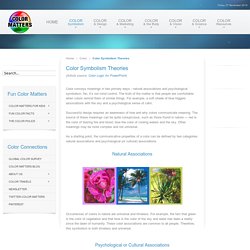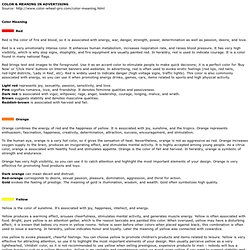

Color Symbolism Theories. (Article source: Color Logic for PowerPoint) Color conveys meanings in two primary ways - natural associations and psychological symbolism.

No, it’s not mind control. The truth of the matter is that people are comfortable when colors remind them of similar things. For example, a soft shade of blue triggers associations with the sky and a psychological sense of calm. Successful design requires an awareness of how and why colors communicate meaning. As a starting point, the communicative properties of a color can be defined by two categories: natural associations and psychological (or cultural) associations.
Natural Associations Occurrences of colors in nature are universal and timeless. Psychological or Cultural Associations Color may generate another level of meaning in the mind. Furthermore, color may have both positive and negative symbolism. Advertisement 1. Color & Meaning In Advertising. COLOR & MEANING IN ADVERTISING Source: Red Red is the color of fire and blood, so it is associated with energy, war, danger, strength, power, determination as well as passion, desire, and love.

Red is a very emotionally intense color. It enhances human metabolism, increases respiration rate, and raises blood pressure. It has very high visibility, which is why stop signs, stoplights, and fire equipment are usually painted red. Red brings text and images to the foreground. Light red represents joy, sexuality, passion, sensitivity, and love.Pink signifies romance, love, and friendship. Orange Orange combines the energy of red and the happiness of yellow.
To the human eye, orange is a very hot color, so it gives the sensation of heat. Orange has very high visibility, so you can use it to catch attention and highlight the most important elements of your design. Yellow. Symbolism and colors in advertising. Did You Know?: The Meaning of Colors - Color Symbolism.
Just imagine how this world would be without colors or better still imagine yourself living in a world that is only in black and white.

Would life be as beautiful, enjoyable and splendid as how it is now with regards to color? The beautiful blue sky would lose its unique color, trees and flowers their splendid colors just to name a few. Our behavior towards a lot of things that control our present lives would not exist. No it wouldn’t, color affects us both physiologically and psychologically that impacts on our lives greatly both consciously and unconsciously.
Color symbolism can vary dramatically between various cultures around the world that perceive colors completely different. Color: Meaning, Symbolism and Psychology. Green occupies more space in the spectrum visible to the human eye and is second only to blue as a favorite color.

Green is the pervasive color in the natural world that is an ideal backdrop in interior design because we are so used to seeing it everywhere. The natural greens, from forest to lime, are seen as tranquil and refreshing, with a natural balance of cool and warm (blue and yellow) undertones. Green is considered the color of peace and ecology. However, there is an "institutional" side to green, associated with illness or Government-issued that conjure up negative emotions as do the "slimy" or bilious greens. How the color green affects us physically and mentally * Soothing * Relaxing mentally as well as physically * Helps alleviate depression, nervousness and anxiety * Offers a sense of renewal, self-control and harmony For more information see "All About the Color Green" Color symbolism.
Color symbolism in art and anthropology refers to the use of color as a symbol in various cultures.

There is great diversity in the use of colors and their associations between cultures[1] and even within the same culture in different time periods.[2] In fact, the same color may have very different associations within the same culture at any time. For example, red is often used for stop signs[3] or danger.[4] At the same time, red is also frequently used in association with romance, e.g. with Valentine's Day.[5] White variously signifies purity, innocence, wisdom or death.
Blue has similarly diverse meanings. Symbolic representations of religious concepts or articles may include a specific color with which the concept or object is associated.[6] There is evidence to suggest that colors have been used for this purpose as early as 90,000 BC.[7] Extensive associations for each color are listed in their respective articles. See also[edit] References[edit] External links[edit]
Symbolism: Colors. Symbolism of Color: Using Color for Meaning. Symbolism and color.